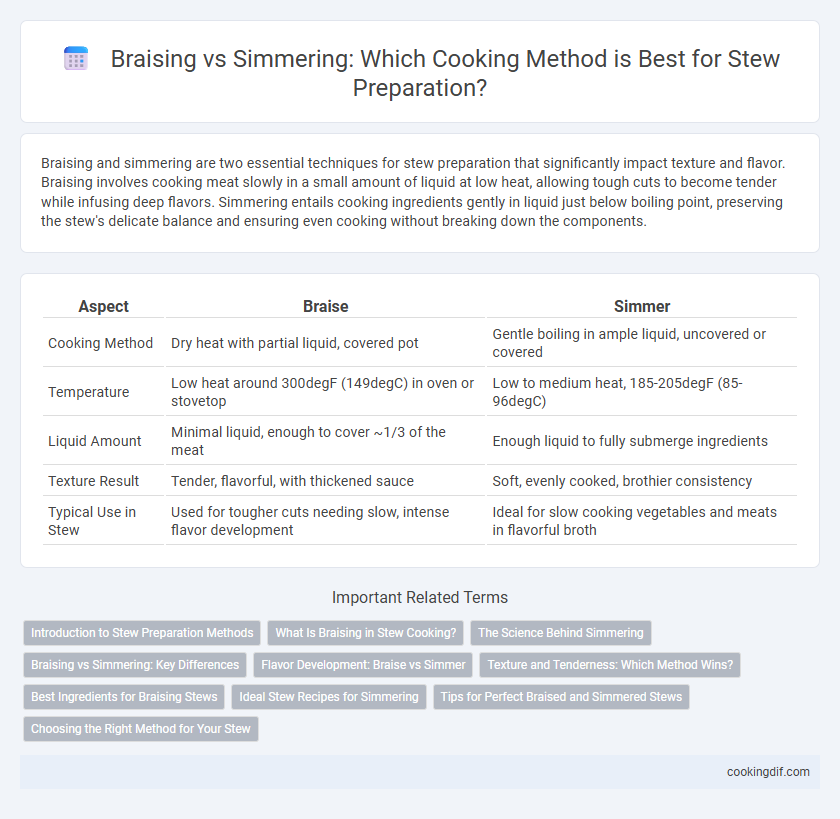Braising and simmering are two essential techniques for stew preparation that significantly impact texture and flavor. Braising involves cooking meat slowly in a small amount of liquid at low heat, allowing tough cuts to become tender while infusing deep flavors. Simmering entails cooking ingredients gently in liquid just below boiling point, preserving the stew's delicate balance and ensuring even cooking without breaking down the components.
Table of Comparison
| Aspect | Braise | Simmer |
|---|---|---|
| Cooking Method | Dry heat with partial liquid, covered pot | Gentle boiling in ample liquid, uncovered or covered |
| Temperature | Low heat around 300degF (149degC) in oven or stovetop | Low to medium heat, 185-205degF (85-96degC) |
| Liquid Amount | Minimal liquid, enough to cover ~1/3 of the meat | Enough liquid to fully submerge ingredients |
| Texture Result | Tender, flavorful, with thickened sauce | Soft, evenly cooked, brothier consistency |
| Typical Use in Stew | Used for tougher cuts needing slow, intense flavor development | Ideal for slow cooking vegetables and meats in flavorful broth |
Introduction to Stew Preparation Methods
Braising involves cooking meat slowly in a small amount of liquid at a low temperature, allowing connective tissues to break down and intensify flavors, ideal for tougher cuts like chuck or brisket. Simmering maintains a gentle, consistent heat just below boiling, perfect for cooking vegetables and tender meats evenly without toughening them. Choosing braise or simmer depends on the stew's ingredients and desired texture, with braising enhancing meat tenderness and simmering ensuring a balanced blend of flavors.
What Is Braising in Stew Cooking?
Braising in stew cooking involves searing meat at high heat followed by slow cooking in a small amount of liquid, which enhances flavor and tenderness. This method uses both dry and wet heat, allowing connective tissues in tougher cuts to break down, resulting in rich, succulent stew. Compared to simmering, braising maintains higher initial temperatures, creating a caramelized crust that deepens the stew's overall taste profile.
The Science Behind Simmering
Simmering a stew involves maintaining a liquid temperature just below boiling, typically around 185degF to 205degF (85degC to 96degC), which allows gentle cooking and even heat distribution. This controlled temperature prevents meat proteins from contracting violently, resulting in tender, juicy textures as collagen gradually breaks down into gelatin, enriching the stew's mouthfeel. Unlike braising, which often incorporates oven cooking at steady low heat, simmering promotes consistent moisture retention and flavor melding through subtle convection currents in the pot.
Braising vs Simmering: Key Differences
Braising involves cooking meat slowly in a small amount of liquid at low heat, allowing connective tissues to break down for tender, flavorful stew. Simmering, on the other hand, uses a gentler heat with the stew submerged in liquid, maintaining a steady temperature just below boiling to cook ingredients evenly. Braising typically produces richer, more concentrated flavors, while simmering is ideal for delicate ingredients that require gentle cooking to preserve texture.
Flavor Development: Braise vs Simmer
Braising stew involves cooking meat slowly in a small amount of liquid at a low temperature, which enhances flavor development by allowing Maillard reactions to create deep, complex taste profiles. Simmering stew, on the other hand, cooks ingredients fully submerged at a slightly higher temperature, preserving more subtle flavors but often resulting in a lighter taste. The extended, gentle heat of braising promotes richer umami notes and tender texture, making it ideal for robust, hearty stews.
Texture and Tenderness: Which Method Wins?
Braising stews in low heat with minimal liquid yields a rich, tender texture by breaking down tougher cuts of meat slowly, making the fibers soft and succulent. Simmering maintains a gentler bubble throughout, preserving ingredient integrity but often resulting in a slightly firmer texture that may not achieve the same level of tenderness as braising. For optimal stew preparation, braising typically wins in enhancing tenderness and creating melt-in-the-mouth textures crucial for hearty, comforting dishes.
Best Ingredients for Braising Stews
Braising stews requires tougher cuts of meat like chuck, brisket, or short ribs that become tender through slow cooking in a small amount of liquid. Root vegetables such as carrots, potatoes, and parsnips complement the rich flavors and absorb the braising juices effectively. Aromatic herbs like thyme, rosemary, and bay leaves enhance the stew's depth, making these ingredients ideal for braised stew preparation.
Ideal Stew Recipes for Simmering
Simmering is ideal for stew recipes that require gentle, consistent heat to tenderize meat and meld flavors without breaking down vegetables or proteins excessively. Maintaining a simmer temperature around 185-205degF (85-96degC) ensures the liquid bubbles softly, preserving texture and enhancing the stew's rich, complex taste. Recipes like classic beef stew or chicken vegetable stew benefit from simmering to develop deep, savory profiles with a balanced, hearty consistency.
Tips for Perfect Braised and Simmered Stews
For perfect braised stews, use a heavy pot with a tight-fitting lid to retain moisture and cook tougher cuts of meat slowly at low heat, allowing flavors to deeply meld. When simmering, maintain a gentle, consistent temperature just below boiling to prevent toughness and promote even cooking of vegetables and proteins. Monitor liquid levels closely to avoid drying out or over-thickening, ensuring a rich, tender, and flavorful stew.
Choosing the Right Method for Your Stew
Braising is ideal for tougher cuts of meat, cooking them slowly in a small amount of liquid to achieve tender, flavorful results through controlled, low heat and steam. Simmering involves cooking ingredients fully submerged in a gently bubbling liquid, perfect for blending flavors in soups and broths while preserving texture. Selecting between braising and simmering depends on the cut of meat and desired stew consistency, with braising enhancing depth and simmering ensuring even cooking.
Braise vs Simmer for stew preparation Infographic

 cookingdif.com
cookingdif.com